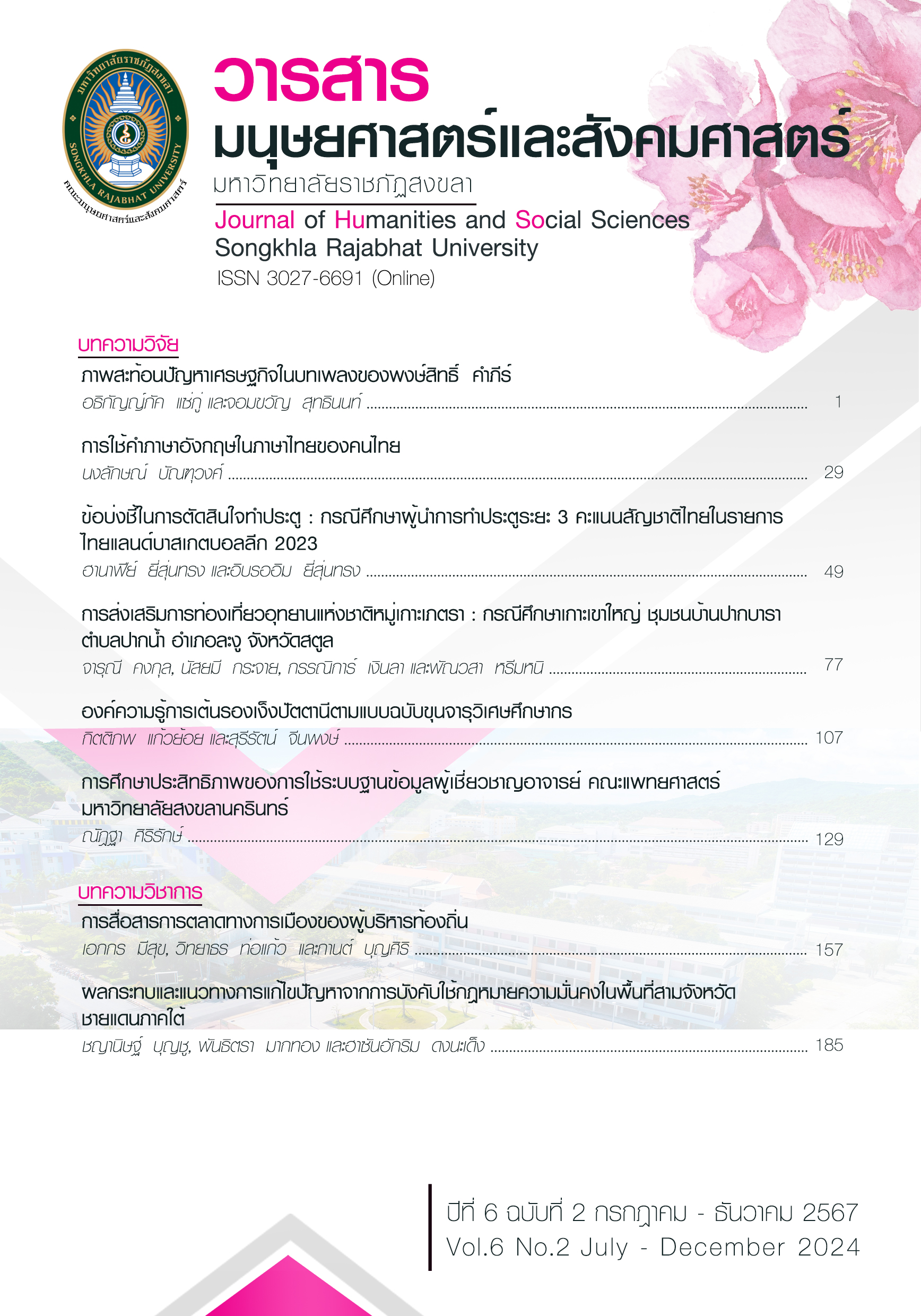KNOWLEDGE OF PATTANI RONGNGENG DANCE ACCORDING TO KHUN JARU WISET SUKSA KORN
Main Article Content
Abstract
The purpose of this research is to study and collect knowledge of the Pattani Rongngeng dance according to Khun Jaruwiset Suksakarn's style using a qualitative research approach. The research found that the important knowledge of the Pattani Rongngeng dance according to the style of Khun Jaruwiset Suksakarn is the 9 elements of the performance: 1. Male and female dancers dance together in 1 or more pairs and 4 - 6 musicians. 2. Male dancers dress in Saleenae, female dancers wear Banong and the musicians wear a batik shirt which has evolved with the times until it became unique. 3. There are 10 songs in total.
4. The musical instruments of the Rongneng band have further developed, namely, Tambourines and bells also come into the mix. 5. Before and at the end of the dance, the dancers show respect to the audience and partner. 6. The dance moves suggest lovemaking. The specific style of the dance has its rhythm in each song that determines the hands and feet. 7. The row format has evolved to be diverse with the times. 8. The female dancer's performance equipment is a shawl, and the male dancer's is a handkerchief. It is used in the performance to convey the meaning of exchanging things and remembering each other. 9. Performance opportunity is used to welcome guests and at various festivities both in Thailand and abroad.
In addition, this study is beneficial to those who are interested in studying the Pattani Rongngeng dance according to Khun Jaruwiset Suksakarn's style by learning about the elements of the show from the past and how it has developed until the present.
Downloads
Article Details

This work is licensed under a Creative Commons Attribution-NonCommercial-NoDerivatives 4.0 International License.
ลิขสิทธิ
References
เจษฎา เนตรพลับ และวีรชาติ เปรมานนท์. (2559). นาฏยศิลป์พื้นเมืองมลายูปาตานี. วารสารวิทยบริการมหาวิทยาลัยสงขลานครินทร์. 27(2), 1-13.
ทัศนียา คัญทะชา. (2551). รองเง็งปัตตานี: มรดกทางวัฒนธรรมที่รอคอยการฟื้นฟู. วารสารสำนักหอสมุด มหาวิทยาลัยทักษิณ. 7(2), 60-66.
พรเทพ บุญจันทร์เพ็ชร์ และสุภาวดี โพธิเวชกุล. (2562). นาฏยลักษณ์การแสดงของวังยะหริ่งจังหวัดปัตตานี. วารสารศิลปกรรมศาสตร์ มหาวิทยาลัยขอนแก่น. 11(2), 197-221.
วลัยลักษณ์ ทรงศิริ. (2553). ความเชื่อและวัฒนธรรมท้องถิ่นปัตตานี: ความทรงจำที่ถูกละทิ้ง. วารสารรูซามิแล. 31(3), 23-34.
สุรพล วิรุฬห์รักษ์. (2544). นาฏศิลป์ปริทรรศน์. กรุงเทพฯ: จุฬาลงกรณ์มหาวิทยาลัย.
อัชฌายง ตรีสมุทร และสุภาวดี โพธิเวชกุล. (2564). วิธีการแสดงลิเกคณะศรรามน้ำเพชร. วารสารอิเล็กทรอนิกส์การ เรียนรู้ทางไกลเชิงนวัตกรรม. 11(2), 100-111.
Voget, F. W. (1956). The American Indian in Transition: Reformation and Accommodation. American Anthropologist. 58(2), 249-263.
Wallace, A. F. C. (1956). Revitalization Movements. American Anthropologist. 58(2), 264-281.


